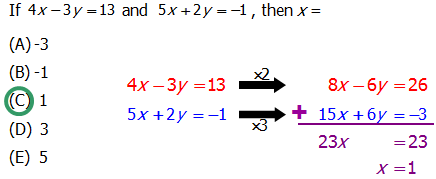
Fact: If you have two variables and only one equation, in general you will not be able to solve for the individual values of the variables. You need two separate equations in order to solve for the individual values of each of two variables. (This fact is crucially important on the Quantitative Section.)
More Advanced Fact: As a general rule, if you wish to solve for the values of n different variables, you need at least n different equations. (If
Just this one mathematical fact, the first one, has powerful implications for hundreds of possible DS questions. Consider this template DS question:
Q1. In blah blah blah scenario,
Statement #1:
Statement #2:
Statement #1: two variables, one equation, not sufficient by itself.
Statement #2: two variables, one equation, not sufficient by itself.
Combined: two equations, two variables, can be solved, sufficient.
Done.
Answer = C
Notice, we had to do a minimum of math to solve this question. Just this one fact can make short work of any of a number of seeming complicated DS questions. Often, notice that the “equations” are given in verbal form: one first has to translate, but once you realize the verbal information constitutes an equation, you don’t even need to find the question: you can just use this logic to power through to an answer.
Your Algebra Two teacher probably taught you two different ways to solve these equations. For simplicity, I am just going to review one method, the one that is most useful in solving the systems of equations you will see on the QUANT. If you remember the other method, and prefer that, by all means use it.
The method I am going to review is sometimes called “elimination” or “linear combination.” Here is the strategy.
Step #1 — Multiply one or both equations so that the coefficients of the same variable are opposites of each other (e.g.
Step #2 — Add the two equations
Sometimes you get very lucky because in the equation, as given, coefficients of one variable already are opposites, so you can bypass Step #1 and proceed immediately to Step #2.
I’ll demonstrate with the two equations in my hypothetical question above. Suppose, in a PS question we were given those two equations
Once we know
Consider this question:
Q2. The symphony sells two kinds of tickets: orchestra, for
(A)
(B)
(C)
(D)
(E)
Notice, in verbal form, this is a two-equations-two variables problem. The two variables are
and
One equation we get is
The first equation is incredibly convenient to multiply. I would rather multiply by

Now, at first blush, that might look like an ugly division problem awaiting us,
Now,
We want
Answer = A
BTW, if these steps totally elude you, remember you can always backsolve from the numerical answers as a backup strategy.
Q3. If

Answer = C